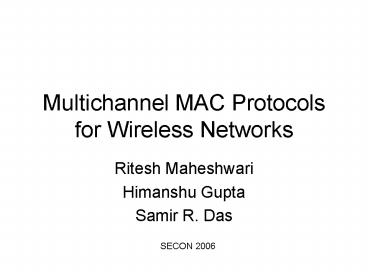Multichannel MAC Protocols for Wireless Networks - PowerPoint PPT Presentation
1 / 20
Title:
Multichannel MAC Protocols for Wireless Networks
Description:
The research community has been addressing the multichannel question using two ... is akin to the problem of coloring vertices of a graph with available channels ... – PowerPoint PPT presentation
Number of Views:70
Avg rating:3.0/5.0
Title: Multichannel MAC Protocols for Wireless Networks
1
Multichannel MAC Protocols for Wireless Networks
- Ritesh Maheshwari
- Himanshu Gupta
- Samir R. Das
SECON 2006
2
Outline
- Introduction
- Background and related work
- Receiver directed transmission and performance
issues - xRDT Extended Receiver Directed Transmission
scheme - Local Coordination-based Multichannel (LCM) MAC
- Simulation-based performance evaluation
- Conclusions
3
Introduction
- The research community has been addressing the
multichannel question using two very different
approaches. - The first is a static approach based on topology
control - The other approach is more dynamic
4
Introduction (cont.)
- 2 MAC protocol
- Extended receiver directed transmission (xRDT)
- uses one packet interface and one busy tone
interface - local coordination-based multichannel (LCM) MAC
- uses a single packet interface only
5
Background and related work
- Dynamic approach
- SSCH
- Switche channels at slot-boundaries in a
pseudo-random sequence - MMAC
- Beacon intervalATIM window Data window
- RDT
- Quiescent channel
- DCA
- 1 ctrl channel, others data channel
6
Receiver Directed Transmission and performance
issues
- Every node is assumed to be have a single
interface and also selects a well-known
quiescent channel for itself
1?2
2?1
2
2
A
A
B
B
(1)
(1)
(2)
(2)
7
Multichannel hidden terminal problem
(2)
(2)
(1)
(1)
C
B
A
D
RTS (2)
CTS (2)
CTS (2)
Data (2)
Collision
8
Deafness problem
(3)
(2)
(1)
B
C
A
2?3
1?2
DATA (3)
Backoff Retry ...
3?2
9
xRDT Extended Receiver Directed Transmission
scheme
- Addressing multichannel hidden terminal
- Channel memory helps propagate the channel state
to a potential transmitter at all times--busy
tone - A receiver when receiving a data packet on
channel c turns on the tone in corresponding busy
tone channel bc. - Use of the busy tone prevents any collision of
data packets.
10
xRDT (cont.)
- Addressing deafness
- The deaf nodes broadcast a Data Transmission
Complete (DTC) notification message in its own
quiescent channel - Ensure that all potential transmitters (who may
be in backoff) come to know of the receivers
availability - DTC does not prevent deafness
11
xRDT (cont.)
Switch to q and sense
Switch to p
DATA(q)
RTS(q)
DTC(p)
A (p)
B (q)
ACK packet duration
off
on
on
bq
Interframe spacing
DTC(bp)
bp
12
xRDT (cont.)
- Selection of quiescent channel
- Optimized assignment of quiescent channels is
akin to the problem of coloring vertices of a
graph with available channels - Find maximum weighted k-cut in the G2 graph
- G is the original communication graph and G2 has
edges between node pairs (i j) such that
distance between i and j in G is at most 2
i
j
1
2
13
Local Coordination-based Multichannel (LCM) MAC
- Use only one interface
- Ctrl window data window
- All control packets are transmitted in the same
channel during the control window. All nodes in a
neighborhood are tuned to this same channel at
this time. - Avoid multichannel hidden terminal and deafness
- All data packets are transmitted concurrently in
different channels during the data window. - Data packet transmit parallelly on different
channels
14
LCM MAC (cont.)
Master node
nTneg or (k1)Tneg
DATAACKinterframe spacings
RTS ctrl window duration, data window duration,
a list of free channels CTS a channel id,
schedual information RES a channel id, schedual
information
Set NAV
15
LCM MAC (cont.)
inflexible bit0 in RTS B can send a CTS with a
changed schedule to match its own
16
Simulation-based performance evaluation
- Ns2 simulator
- Transmission range 250m
- Carrier sense range 500m
- Nominal bit rate of each channel 1 Mbps
- 100 nodes at random locations (50 CBR)
- Data packet sizes 1000 bytes
- Shortest path routing
17
Simulation-based performance evaluation (cont.)
2 interface protocol
1 interface protocol
6 channel
13 channel
Throughput vs. load in ns2 simulations with 1Mbps
channels, 100 nodes in a 500m X 500m area.
18
Simulation-based performance evaluation (cont.)
6 channel
13 channel
Throughput vs. load in ns2 simulations with 1Mbps
channels, 100 nodes in a 1000m X1000m area.
19
Simulation-based performance evaluation (cont.)
A chart comparing saturation throughput of xRDT
and LCM MAC with varying number of channels in a
500m X 500m area. The chart also includes single
channel 802.11 for baseline comparison
20
Conclusions
- This paper developed two multichannel MAC
protocols - xRDT with a packet and a busy tone interface
- LCM MAC, with just one interface































